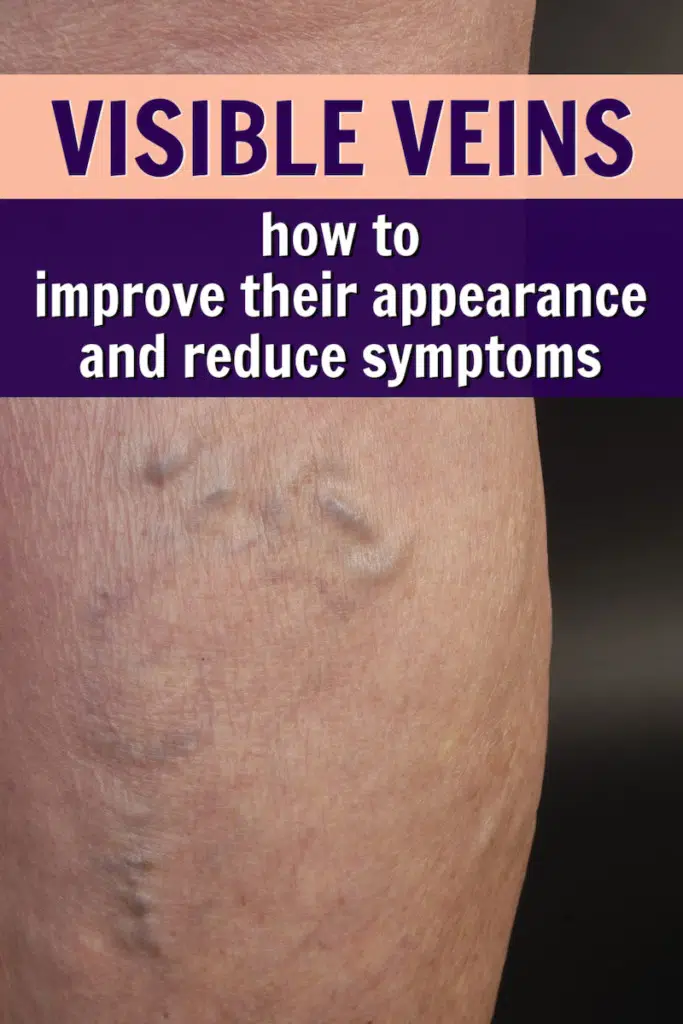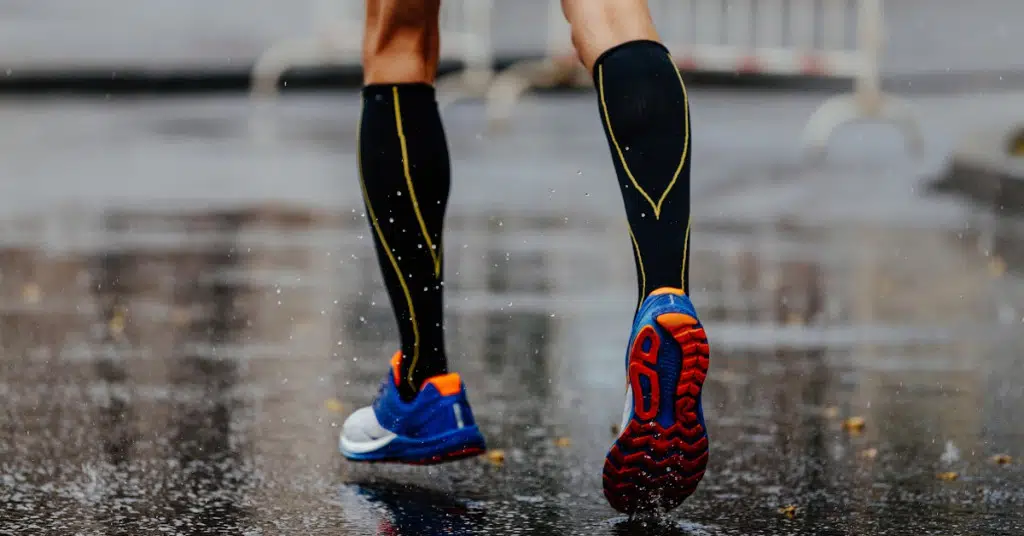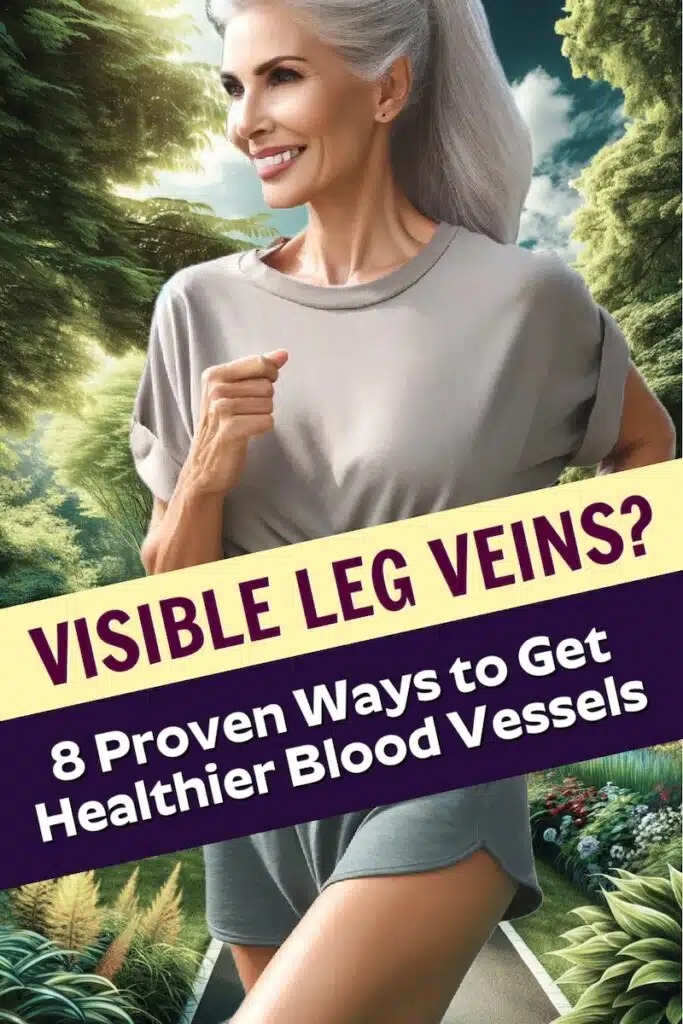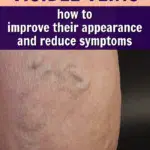Varicose veins, spider veins, and bulging leg veins happen increasingly with age.
Here are the different types of visible leg veins, what causes them, and eight proven methods for alleviating their symptoms, reducing their appearance, and improving your overall vein health.
The Genetic Factor in Vein Visibility
If you’re like me, you might have a genetic propensity toward vein visibility.
I have thin, sensitive skin, a fair complexion, and a propensity toward lower body fat.
That, coupled with the fact that I’m approaching 60, means my veins are more visible than the average person’s:
- I live in a year-round warm climate and like to wear shorts (after training legs at the gym, my thighs and calves sometimes look like 3-D roadmaps).
- Though vascularity is considered attractive in the world of physique development (the coveted “pump”), I do sometimes wish my veins were less obvious – so I take a special interest in using other lifestyle factors to help mitigate vein visibility and keep my blood vessels healthy.

Unfortunately, you cannot control your family history or your age, and these two factors do influence vein visibility and vein health:
- If your parents had vein conditions, it may also contribute to your risk of having them.
- Furthermore, older age is one of the main risk factors for varicose veins. Typically, people are considered at a higher risk of developing these symptoms if they’re over 60, but it’s possible to develop them earlier.
When Veins Go Wrong
The primary function of veins is to transport deoxygenated blood back to the heart and lungs, where it can be oxygenated and returned to the body’s tissues.
Sometimes, however, veins become strained – and this tends to make them more visible and less functional.
Veins have valves that prevent blood from flowing backward. As we age, these valves can be negatively affected due to a range of factors.
Healthier Legs: Effective Methods for Reducing Varicose and Spider Veins
Several vein diseases can affect the veins in the body. They sometimes result in purplish or greenish veins that are visible, because of blood pooling in the weakened vessels.
Varicose Veins
Varicose veins are swollen and twisted veins, usually visible on the surface of the skin.
They are most commonly found in the legs and are caused by a weakness in the vein walls or valves, which allows blood to flow backward and pool in the veins (the pressure on veins in the lower part of your body increases when you stand or walk).
Varicose veins are sometimes superficial – they may be unsightly but are painless and usually not dangerous.
Though less common, some varicose veins can pose a health risk – such as skin ulcers, blood clots, and bleeding – and they might also be uncomfortable or itchy. Your medical doctor or vein specialist can provide insight into how benign or problematic your varicose veins might be.
Spider Veins
Spider veins are the most minor type of varicose veins.
Like varicose veins, spider veins are dilated blood vessels with weaker valves. These are small, thin veins that are visible on the surface of the skin. They are usually found on the legs and face and are not usually a serious medical concern.
Bulging Leg Veins
Bulging leg veins are not always a result of weakened vessels but sometimes just the visual result of a mature person who exercises regularly and maintains a lower percentage of body fat.

Veins become more visible without an ample layer of subcutaneous fat sitting right under the skin.
Deep Vein Thrombosis
Deep Vein Thrombosis (DVT) is a blood clot that forms in a deep vein, usually in the leg.
DVT can cause pain and swelling, and if left untreated, it can lead to serious complications such as pulmonary embolism.
Venous Insufficiency
Venous insufficiency is a condition in which the veins are unable to pump blood back to the heart effectively. It can cause symptoms such as swelling, fatigue, and pain in the legs.
“Vein diseases often result from the failure of tiny vein valves in the legs to function normally, causing blood to accumulate.”
–Dr. George Bolotin
Phlebitis
Phlebitis is inflammation of a vein, often caused by a blood clot or infection. It can cause pain, swelling, and redness in the affected area.
It’s important to seek medical attention if you are experiencing any symptoms of vein disease, as early treatment can often help prevent serious complications.
The Purpose of Your Veins
Veins are blood vessels that carry blood toward the heart.
In the human body, veins serve several important functions:
- Return of blood to the heart. Veins transport deoxygenated blood from the tissues back to the heart, which can be oxygenated and re-circulated through the body.
- Regulation of blood flow. Veins contain valves that prevent the backflow of blood, which helps to maintain the flow of blood toward the heart.
- Regulation of body temperature. Veins are located close to the surface of the skin, which allows them to help regulate body temperature by dissipating heat.
- Storage of blood. Veins can store blood and release it into circulation as needed.
Shrink Those Varicose Veins: Best Ways to Improve Leg Circulation
You can have healthier, better-looking legs! Here are methods to reduce the severity of your bulging leg veins or varicose veins.
1. Increase Your Level of Physical Activity
Sitting or standing for long periods can put undue pressure on leg veins and worsen symptoms.
A sedentary job may increase your risk of developing bulging leg veins – so can playing computer video games, watching television for long periods, desk-sitting, and numbed-out scrolling and swiping on smartphones.
Avoid this risk factor by getting up and moving around as often as possible. There are several ways you can do this:
- If you’re sitting down, try to stand up every 20 minutes and stretch your legs.
- Keep your knees slightly soft if standing up, and shift your weight from one foot to the other every 10 minutes.
- If you’re at a desk, try doing calf exercises – such as heel raises – as you sit, or do a few minutes of core conditioning.
- Regular exercise helps keep blood flowing smoothly throughout your legs. Walking is an effective low-impact exercise for preventing and treating varicose veins. It stimulates circulation and strengthens the muscles in your legs to improve blood flow. Doctors often recommend a daily walk for around 30-45 minutes.
2. Wear Compression Socks or Compression Leggings
Compression wear has come a long way in recent years. In your grandparent’s day, ugly beige compression socks were the only choice – but today’s compression wear comes in all types, textures, and colors.

The idea behind compression wear is fundamental: specialized fabric applies pressure on the surface of particular parts of the body to compress and support underlying tissue. The hope is that this increases the body’s blood circulation and eases vein swelling.
3. Reduce Your Overall Percentage of Body Fat
Being overweight or obese can cause symptoms of varicose veins, bulging leg veins, and spider veins. Excess adipose tissue within your physique places extra pressure on the veins in your lower body.
Consistently strive to reduce your overall body fat percentage since the risk of having varicose veins is higher in people who are overweight or obese.
If you’re unsure whether you’re overweight, you can use an online Body Mass Index (BMI) calculator to determine your BMI based on height and weight. A BMI above 25 is considered “overweight,” and a BMI above 30 is classified as “obese.”
4. Take Horse Chestnut Seed Extract for Varicose Veins and Bulging Leg Veins
Horse Chestnut seed extract is thought to assist in maintaining healthy peripheral circulation in the body while supporting healthy tissue fluid levels – including in the legs.
For example, Standard Process is a company that makes a capsule called Vascular Care Complex formulated with steroidal saponins (such as escin), flavonoids, lipids, sterols, terpene lactones (including ginkgo), and other phytochemicals – like butcher’s broom and rhizome. This formula is designed to assist in vein health.
5. Do Inversion Poses
Modern life presents certain disadvantages. From an ancestral perspective, our human bodies were probably not designed to stand and sit for long periods. If you are experiencing varicose veins, try elevating your legs above your hips for short periods (from 3 to 20 minutes, depending on your current state of mobility and fitness):
- While lying down, place pillows under your feet to raise them above heart level so that gravity can help with circulation.
- Try the “Legs Up the Wall” pose. Remove your shoes and lay on your side in the shape of an embryo, scooting your hips to the wall. Then, gradually roll onto your back and place your stocking feet up on the wall. To deepen this stretch, place a shallow pillow underneath your hips.
- Do a yoga handstand against a wall.
- Use an inversion table to hang upside down (be sure someone is home with you as a safety precaution).
These inverted postures help ease the body by preventing blood from pooling in the lower extremities and allowing blood to flow back to the heart more easily.
6. Take Diosmin for Varicose Veins and Spider Veins
Diosmin is a nutritional supplement, available most often in a capsule formulated with hesperidin. It’s made from the extract of citrus foods and is purported to support blood flow in the body. It’s sometimes taken by those wishing to reduce symptoms of hemorrhoids or bulging varicose leg veins. Though some might have a negative sensitivity to Diosmin, it works well for many people.
Interestingly, there has been some indication that Sildenafil might one day have applications for improving vein health. Sildenafil – the active ingredient within Viagra – works by relaxing blood vessels and increasing blood flow. And, yes, Sildenafil has potential applications for women, too.
In some cases, the increased blood flow from taking Sildenafil might help prevent blood from pooling in the veins (pooling which can contribute to the development of varicose veins or spider veins). However, evidence so far – though intriguing – is inconclusive and more research needs to be conducted before Sildenafil can be an established protocol for vein health. It may be that the risks outweigh the benefits.
7. Stop Crossing Your Legs
Crossing your legs can put undue pressure on your veins. Try not to cross your legs while sitting. Or, if you like to sit cross-legged like a yogi, place child pillows (you can find these in home-supply stores) in between (where one leg would touch the other), which will reduce direct pressure.

8. Increase Your Vegetable Intake
An anti-inflammatory diet is a lifestyle change in which you remove the foods your body finds subtly irritating and eat only the foods your body finds unquestionably empowering. Usually, this means a diet of mostly vegetables and quality meats.
In 2018, researchers examined the association between vegetable intake and chronic venous insufficiency (CVI) and venous reflux in the legs. The study included 3,218 participants from the Edinburgh Vein Study, who completed a food frequency questionnaire and underwent duplex ultrasonography to assess CVI and venous reflux.
Results showed that participants who consumed more vegetables had a lower prevalence of CVI and venous reflux in the legs.
Specifically, participants who consumed three or more servings of vegetables per day had a 41% lower odds of CVI and a 27% lower odds of venous reflux compared to those who consumed less than one serving per day.
Increased vegetable intake likely improves vein health. This study suggests that incorporating more vegetables into one’s diet may be a simple and effective way to help your veins work better.
On an anti-inflammatory diet, you’re encouraged to eat 9 loose cups of vegetables each day, from the full rainbow of colors.
Chances are, you’re eating a fraction of that.
A green smoothie is a blended drink made with vegetables, fruits, and nuts. The main idea behind a green smoothie is to provide a concentrated source of essential nutrients and fiber in an easy-to-digest form.
Some benefits of green smoothies include:
- Nutrient-dense: Green smoothies are rich in vitamins, minerals, and antioxidants, which can help support overall health and protect against disease.
- Improved Digestion: The fiber in green smoothies can help promote regular bowel movements and support a healthy gut microbiome.
- Energy boost: The vegetables within a green smoothie provide a natural source of sustained energy – without the crash often associated with sugary drinks.
- Hydration: Green smoothies are an effective way to stay hydrated.
My weekly email update includes recipes and tips about green smoothies. Green smoothies keep you strong. They get all those vegetables – your daily servings of vegetables – into your diet that lengthen your life and improve your energy level.
Other Factors Contributing to Visible Veins
This probably goes without saying, but tobacco use can increase the risk of developing varicose veins, so if you’re a smoker or chewer, you may want to consider quitting.
Tobacco smoke contains carbon monoxide:
- Carbon monoxide doesn’t allow your blood to carry oxygen and other nutrients as well as it would otherwise.
- Carbon monoxide also contributes to a hardening of the arteries, which forces your heart to work harder to move blood through them.
- This extra work can expand the size of your left ventricle, making it less efficient at pumping blood.
- With a weakened circulatory system, there’s an increased risk that pressure in your leg veins will be too high and cause bulging or twisting.
Try cutting back on cigarettes (or chewing tobacco); it could help keep your heart healthy and reduce your risk for varicose veins.
When Should I Worry about Bulging Leg Veins?
For the most part, bulging leg veins are harmless. They may cause discomfort; they may be unsightly. But, in general, you shouldn’t worry about them unless they:
- Cause pain or heaviness in your legs.
- Are accompanied by a swollen leg.
Leg injuries can also cause long-term problems for leg veins. You must see your family doctor immediately if you experience a deep cut or severe bruise. He or she may prescribe anticoagulants to prevent blood clots from forming in the area of the injury.
What Happens If Varicose Veins Are Left Untreated?
Although varicose veins are usually not dangerous, leaving them untreated can lead to various problems, some of which can have severe concerns regarding one’s health.
In cases where varicose veins are severe, this may indicate chronic venous insufficiency. This condition affects the ability of your veins to pump blood into your heart.
People who have varicose veins are at more risk of developing blood clots.
Surgical Solutions for Visible Varicose Veins
There are surgical options for bulging and varicose veins. Usually, the veins are “stripped” (removed) during processes referred to as phlebectomy or ligation.
Another option is the use of lasers, called endothermal ablation.
However, if it’s just a tiny patch of spider veins close to the skin’s surface, then a simple shot – in which a salt solution is injected – a process called sclerotherapy or endoscopic – can make them disappear.
A research study published in the New England Journal of Medicine tracked nearly 800 patients who underwent treatments for varicose veins, including laser ablation, foam sclerotherapy, or surgery. The study found that six months after treatment, laser ablation and surgery ranked above foam sclerotherapy in terms of patient satisfaction. Laser ablation and surgery were more effective in eliminating varicose veins, with laser ablation having fewer side effects like bleeding and bruising compared to foam sclerotherapy.
Conclusion on Effective Methods to Alleviate Varicose Veins and Improve Vein Health
You can reduce your risk of developing bulging leg veins or varicose veins and improve your legs’ overall health and appearance.
However, I encourage you to consult with your own medical doctor to discuss vein health before beginning any significant interventions.
Vein health is an important aspect of overall wellness. By making healthy lifestyle choices and seeking medical attention when needed, you can keep your legs looking and feeling their best.
Additional Resources on Varicose Veins:
Leg Elevation for Bulging Leg Veins and Varicose Veins – https://stanfordhealthcare.org/medical-conditions/blood-heart-circulation/varicose-veins/treatments/elevation-legs.html
Exercises to Help Mitigate Varicose Veins – https://www.webmd.com/skin-problems-and-treatments/best-exercises-varicose-veins
Horse Chestnut and Vein Health – https://examine.com/supplements/horse-chestnut/
Association of Vegetable Intake With Chronic Venous Insufficiency and Venous Reflux in the Legs: The Edinburgh Vein Study – Authors: Mark W. J. Strachan, George Davey Smith – Journal: JAMA Network Open, 2018
